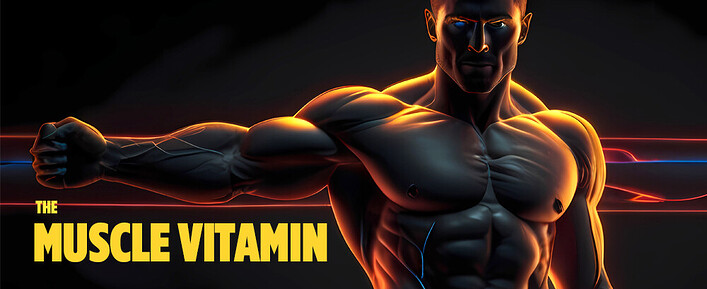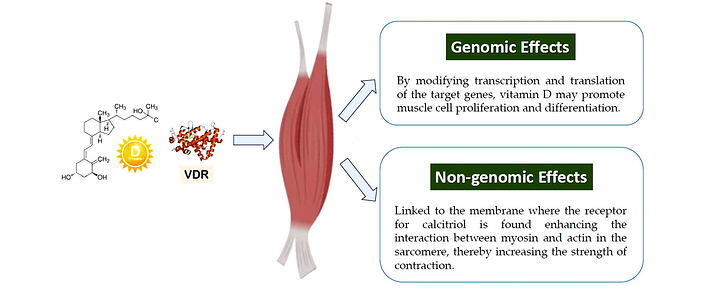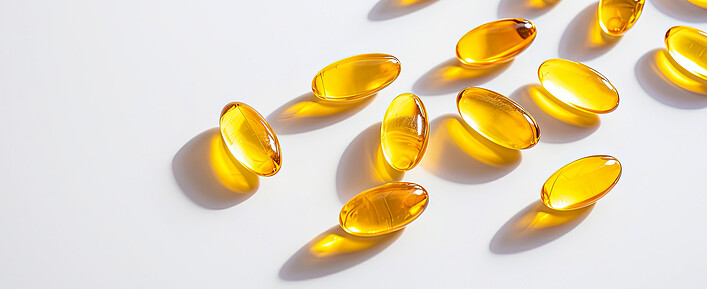If you're not getting enough of vitamin D – and most athletes aren't – you'll have a tougher time building muscle and recovering from workouts.
Let your vitamin D levels tank, and your body will make you pay – sluggishness, hormonal chaos, weakened immunity, and a heavier load of anxiety and depression. Yeah, vitamin D is pretty important.
We always knew vitamin D was crucial, but something happened in 1974 that really drove the point home: a scientist named Mark Haussler formally identified vitamin D receptors (VDRs) in chicken intestines. VDRs act like docking stations for the active form of vitamin D (calcitriol). They're the mediators of vitamin D's effects.
As the years went by, we discovered that these VDRs are all over the human body: the heart, the brain, white blood cells, blood vessels, reproductive organs (testes and ovaries), and more.
But early on, there was some debate about whether VDRs were present in skeletal muscle. It wasn't until 2004 that science confirmed their existence with new technologies. That led to a lot of questions and a lot more research. Like, how is vitamin D related to muscle growth and repair?
Vitamin D for hypertrophy and recovery
Here's what we know today:
First, Vitamin D plays a key role in keeping muscles strong. VDRs help activate processes that build muscle cells and develop type II muscle fibers responsible for quick, powerful movements like sprinting or lifting weights.
Some studies found that taking vitamin D can increase the size of those powerful type II fibers and that having higher vitamin D levels before exercise reduces muscle weakness afterward and helps with recovery.
Here's how it works: Vitamin D binds to the VDR in muscle cells. This triggers two types of responses. First, there's a "genomic" response, which is like editing the muscle's instruction manual. The VDR teams up with another molecule (RXR) to turn on specific genes that control muscle growth.
Second, there's a "nongenomic" response, which is faster, like flipping a switch to quickly boost muscle activity. This action improves how muscle fibers contract, maintains protein balance, and manages calcium levels, crucial for muscle movement. For example, in lab-grown muscle cells, adding vitamin D increases the size of muscle tubes (myotubes) and ramps up proteins like myosin, which help muscles contract.
Vitamin D also helps muscles recover after injury by encouraging cell growth, reducing cell death, and supporting repair. It also fine-tunes calcium movement in muscles, ensuring the machinery of muscle contraction runs smoothly.
In short, having enough vitamin D is vital for athletes and lifters to keep their muscles strong, recover from training, and heal from injuries.
Are you getting enough vitamin D?
Studies show that 32% of NBA players are deficient and 47% have insufficient levels. In the NFL, 26% are deficient, and up to 80% have insufficient levels, despite practicing outdoors and getting sunlight. The stats for regular gym-goers aren't much better.
Traditionally, 30 ng/mL (based on blood tests) is considered a healthy and normal level. Newer, more progressive standards recommend 40-70 ng/mL.
However, some people appear to be "non-responders" to vitamin D supplementation and even sunlight. Several things can cause this:
- Too much body fat
- Low-fat diets
- Being 40+
- Genetic issues
To ensure vitamin D absorption (even with the issues above), use the microencapsulated form containing "caprylocaproyl polyoxyl-8 glycerides" that enhance the bioavailability of drugs and supplements like vitamin D. D Fix High Absorption Vitamin D (Buy at Amazon) contains 5000 IU per softgel.
Reference
- Dominguez, Ligia J., et al. "The Importance of Vitamin D and Magnesium in Athletes." Nutrients, vol. 17, no. 10, 13 May 2025, p. 1655.



